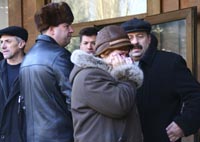Ukraine moans dozens of miners killed in Donetsk
After 69 minors were killed deep underground by a methane blast there is actually no hope to find someone alive.

A raging fire hampered efforts to find the 31 miners still trapped in the massive Zasyadko mine, more than 24 hours after the blast early Sunday, the Emergency Situations Ministry said. More than 360 miners made it alive to the surface of the mine, in the eastern city of Donetsk, officials said.
The methane blast ripped through an area about 1,000 meters (more than 3,300 feet) underground in the mine, one of Ukraine's largest and deepest. One miner said he had to clamber over dead colleagues and navigate through blinding dust to escape.
With the search for survivors still under way, the Donetsk region began three days of official mourning for the victims.
On Sunday, dozens of teary-eyed relatives gathered at the mine's headquarters, waiting anxiously for news on their loved ones. As grim-faced officials emerged to announce the names of the workers found dead, the relatives broke into sobs and cries. Some fainted.
The deadliest accident in Ukraine's coal industry in at least seven years highlighted the lack of attention to safety in a country with some of the world's most dangerous mines.
President Viktor Yushchenko accused his Cabinet on Sunday of not doing enough to reform coal mining, and ordered an official panel to investigate the accident and bring those responsible to account.
Prime Minister Viktor Yanukovych, a native of the mining region, visited the site about 730 kilometers (450 miles) southeast of Kiev, pledging to help victims' families.
Yanukovych, Yushchenko's political rival, suggested the disaster was not caused by safety violations or human error, saying a safety watchdog had reported that miners were working in accordance with norms.
"This accident has proven once again that a human is powerless before nature," he said.
Twenty-eight of the 367 miners evacuated were hospitalized, the Emergency Situations Ministry said.
Vitaliy Kvitkovsky, a miner in his 30s, said he had to walk over the bodies of dead colleagues to climb to the surface.
"The temperature increased sharply, and there was so much dust that I couldn't see anything. ... So I was moving by touch over dead bodies along the rail track," Kvitkovsky said in footage broadcast on Ukraine's Channel 5 television.
Experts say Ukraine's mines are dangerous largely because they are so deep, typically running more than 1,000 meters (3,280 feet) underground. In comparison, most European coal beds lie at a depth of 500 to 600 meters (1,640 to 1,970 feet).
Methane is a natural byproduct of mining, and its concentration increases with depth. More than 75 percent of Ukraine's some 200 coal mines are classified as dangerous due to high methane concentrations.
Mines must be ventilated to prevent explosions, but some rely on outdated ventilation equipment, officials said. Safety violations and negligence add to the problem.
The blast was deadliest mine accident in Ukraine since an explosion at the Barakova mine in the neighboring Luhansk region killed 81 miners in March 2000.
The Zasyadko mine has been plagued by disaster.
Last year, a blast there killed 13 workers. In 2002, an explosion killed 20 and 54 died in a similar explosion in 2001. In May 1999, 50 miners were killed in a methane and coal dust blast there.
Since the 1991 Soviet collapse, more than 4,700 miners in Ukraine have been killed. For every 1 million tons of coal brought to the surface in Ukraine, three miners lose their lives, according to official data.
Despite the dangers, there is growing appetite for Ukraine's rich coal reserves, particularly amid rising natural gas prices. The government has called for production to be increased by a third to 80 million tons this year.
Subscribe to Pravda.Ru Telegram channel, Facebook, RSS!




